

History of Europe - The emergence of modern Europe, 1500–1648. The 16th century was a period of vigorous economic expansion. This expansion in turn played a major role in the many other transformations—social, political, and cultural—of the early modern age. By 1500 the population in most areas of Europe was increasing after two centuries of decline or stagnation. The bonds of commerce within Europe tightened, and the “wheels of commerce” (in the phrase of the 20th-century French historian Fernand Braudel) spun ever faster. Australian National Maritime Museum. Can you Keep Your Convicts Alive?
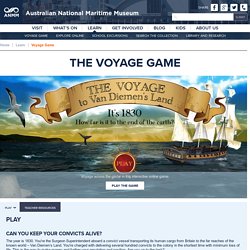
The year is 1830. You're the Surgeon Superintendent aboard a convict vessel transporting its human cargo from Britain to the far reaches of the known world – Van Diemen’s Land. Reasons for European Exploration. Dutch explorers - Australia's migration history timeline. Map from the 15th century depicting Ptolemy’s description of the known world, 1482 engraving by Johannes Schnitzer.
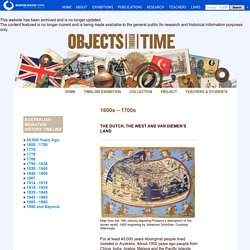
Courtesy Wikimedia For at least 40,000 years Aboriginal people lived isolated in Australia. About 1000 years ago people from China, India, Arabia, Malaya and the Pacific Islands started to explore the oceans around them. It is most likely that these sailors visited the north coast of Australia and traded with Aboriginal people. The Voyages Of Discovery, State Library of NSW. Voyages of Discovery Intro Mapping the World MAPPING THE WORLD The process of cartography or map making has developed over thousands of years.

European discovery of Australia. Key points When European sailors began entering ‘Australian' waters in the early 1600s, they called it Terra Australis Incognita (unknown land of the South).
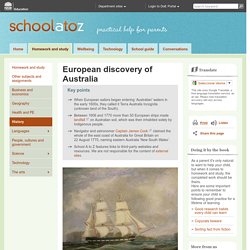
Between 1606 and 1770 more than 50 European ships made landfall on Australian soil, which was then inhabited solely by Indigenous people. The Spanish quest for Terra Australis. My Lord Captain Pedro Fernández de Quirós.
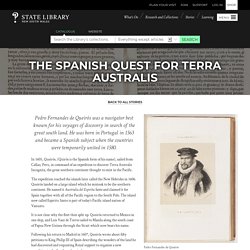
Y.M. instructs and commandsthe Council of the Indies to give me dispatches to my entire satisfaction, so that the Viceroy of Perú can give me whatever I need to populate the Southern Territories where Y.M. has sent me. I always considered it true that the claims about the peoples I discovered and are yet to be discovered, my good faith and just petitions, would reach pious ears and motivate Y.M.’s Christian disposition to the greatness of these two liberal favours I humbly accept, and I thank Y.M. infinitely.
Before Time - Dutch explorers - My Place. For hundreds of years prior to the colonisation of Australia, there were many reports around the world of a great land mass situated to the south of Asia.
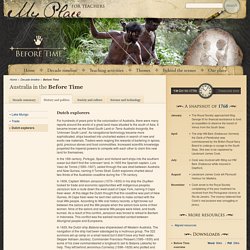
It became known as the Great South Land or Terra Australis Incognita, the 'Unknown South Land'. As navigational technology became more sophisticated, ships travelled into uncharted waters in search of new and exotic raw materials. Traders were reaping the rewards of bartering in spices, gold, precious stones and food commodities. Increased scientific knowledge propelled the imperial powers to compete with each other to claim this new land for themselves. In the 16th century, Portugal, Spain and Holland sent ships into the southern ocean but didn't find the 'unknown' land. Timeline of explorers. Home Our FREE ebooks Search Site Site Map.
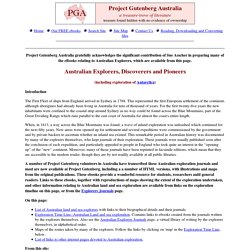
Why a colony? First Fleet. Terra Nullius. First Contact (Indigenous perspective) Convicts. Convict Sydney - Sydney Living Museums. SBS: First Australians. First Australians - Humanities alive 3. 1780s - smallpox epidemic - My Place. From April to May 1789 an outbreak of smallpox devastated Aboriginal clans around the New South Wales colony.

It has been estimated that somewhere between 50 and 70 per cent of the Aboriginal population in the Sydney area died within two years of the British arrival. The Cadigal people, who are the recognised owners of Sydney Cove, suffered great losses from the disease. Impact of colonisation - Australians Together. The colonisation of Australia had a devastating impact on Indigenous people, who have lived on this land for thousands of years.

Prior to British settlement, more than 500 Indigenous groups inhabited the Australian continent, approximately 750,000 people in total.[1] Their cultures developed over 60,000 years, making Indigenous Australians the custodians of the world’s most ancient living culture. Each group lived in close relationship with the land and had custody over their own Country. Captain Cook claims possession for England In 1770, during his first Pacific voyage, Lieutenant James Cook claimed possession of the east coast of Australia for the British Crown.
Upon his return to Britain, Cook’s reports inspired the authorities to establish a penal colony in the newly claimed territory. Australian Aboriginals - history and impact [Video] European Observers - NFSA.